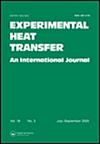Utilizing subsonic vibration in cryogenic quenching for heat flux enhancement
IF 2.5
3区 工程技术
Q2 ENGINEERING, MECHANICAL
引用次数: 2
Abstract
ABSTRACT An active method for heat transfer enhancement is proposed and thoroughly characterized for the first time for cryogenic quenching, in which mechanical vibrations are directly induced onto the sample to be quenched, employing a compact modular system composed of a pneumatic plunging device along with a DC motor/eccentric cam mechanism, generating oscillations on three different axes at a wide array of amplitude-frequency combinations. The quenching performance was investigated from both flow-field and thermal standpoints, through numerical simulations of the flow behavior, high-speed imaging of the process, and experimentally generated transient quenching and boiling curves under the influence of the governing parameters, underlining their combined effect on the mechanism of heat transfer augmentation. Under optimal conditions of amplitude and frequency, a remarkable CHF enhancement of 270% was obtained and the quenching time was reduced from 5 seconds to 1.8 seconds compared to the non-vibration case, where the vibration frequency was found to be the primary factor involved in the increase of oscillation-driven pressure drop and subsequent cavitation-induced CHF enhancement. Consequently, we are providing researchers in the field of cryogenics a method that not only provides enhanced performance but also offers flexibility enabling active control of the governing parameters of the system.利用亚音速振动在深冷淬火中提高热通量
本文章由计算机程序翻译,如有差异,请以英文原文为准。
求助全文
约1分钟内获得全文
求助全文
来源期刊

Experimental Heat Transfer
工程技术-工程:机械
CiteScore
6.30
自引率
37.10%
发文量
61
审稿时长
>12 weeks
期刊介绍:
Experimental Heat Transfer provides a forum for experimentally based high quality research articles and communications in the general area of heat-mass transfer and the related energy fields.
In addition to the established multifaceted areas of heat transfer and the associated thermal energy conversion, transport, and storage, the journal also communicates contributions from new and emerging areas of research such as micro- and nanoscale science and technology, life sciences and biomedical engineering, manufacturing processes, materials science, and engineering. Heat transfer plays an important role in all of these areas, particularly in the form of innovative experiments and systems for direct measurements and analysis, as well as to verify or complement theoretical models.
All submitted manuscripts are subject to initial appraisal by the Editor, and, if found suitable for further consideration, to peer review by independent, anonymous expert referees. All peer reviews are single blind and submission is online via ScholarOne Manuscripts. Original, normal size articles, as well as technical notes are considered. Review articles require previous communication and approval by the Editor before submission for further consideration.
 求助内容:
求助内容: 应助结果提醒方式:
应助结果提醒方式:


